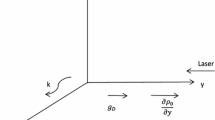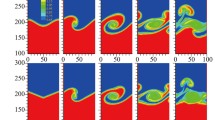Abstract
The direct numerical simulation method is adopted to study the non-linear characteristics of Rayleigh–Taylor instable perturbations at the ablation front of a 200 μm planar CH ablation target. In the simulation, the classical electrical thermal conductivity is included, and NND difference scheme is used. The linear growth rates obtained from the simulation agree with the Takabe formula. The amplitude distribution of the density perturbation at the ablation front is obtained for the linear growth case. The non-linear characteristics of Rayleigh–Taylor instable perturbations are analyzed and the numerical results show that the amplitude distributions of the compulsive harmonics are very different from that of the fundamental perturbation. The characteristics of the amplitude distributions of the harmonics and their fast growth explain why spikes occur at the ablation front. The numerical results also show that non-linear effects have relations with the phase differences of double mode initial perturbations, and different phase differences lead to varied spikes.
Similar content being viewed by others
References
Shiau, J.N., Goldman, E.B., Werg, C.I.: Linear stability analysis of laser-driven spherical implosions. Phys. Rev. Lett. 32, 352–355 (1974)
Goncharov, V.N., Betti, R., Sorotokin, P. et al.: Self-consistent stability analysis of ablation fronts with large Froude numbers. Phys. Plasmas 3, 1402–1414 (1996)
Wang, L.L., Li, J.C.: Numerical study on the Rayleigh–Taylor instability with various initial length scale. High Power Laser Particle Beams 15, 1195–1199 (2003)
Lindl, J.D., Amendt, P., Berger, R.L. et al.: The physics basis for ignition using indirect-drive targets on the National Ignition Facility. Phys. Plasmas 11, 339–491 (2004)
Qin, C.S., Wang, P., Zhang, F.G.: Rayleigh–Taylor and Kelvin–Helmholtz instability of compressible fluid. Acta Mech. Sin. 36, 655–663 (2004) (in Chinese)
Qi, J., Ye, W.H.: Three dimensional parallel computation of laser ablative Rayleigh–Taylor instability. Chin. J. Comput. Phys. 19, 388–392 (2002) (in Chinese)
Sun, Q., Zhou, B., Shen, J. et al.: Modulation targets in Rayleigh–Taylor instability experiments for the ICF study. High Power Laser Particle Beams 16, 1535–1539 (2004)
Kull, H.J.: Incompressible description of Rayleigh–Taylor instabilities in laser-ablated plasmas. Phys. Fluids B 1, 170–182 (1989)
Dahlburg, J.P., Gardner, J.H.: The effect of shape in the three-dimensional ablative Rayleigh–Taylor instability. I: Single-mode perturbations. Phys. Fluids B 5, 571–584 (1993)
Taylor, G.: The instability of liquid surfaces when accelerated in a direction perpendicular to their planes. Proc. R. Lond. Ser. A 201, 192–196 (1950)
McCrory, R.L., Montierth, L., Morse, R.L., Verdon, C.P.: Laser interaction and related plasma phenomena, vol. 5, pp. 713–742. Plenum, New York (1981)
Takabe, H., Mima, K., Montierth, L. et al.: Self-consistent growth rate of the Rayleigh–Taylor instability in an ablatively accelerating plasma. Phys. Fluids 28, 3676–3682 (1985)
Betti, R., Goncharov, V.N., McCrory, R.L. et al.: Growth rates of the ablative Rayleigh–Taylor instability in inertial confinement fusion. Phys. Plasmas 5, 1446–1454 (1998)
Ye, W.H., Zhang, W.Y., He, X.T.: Stabilization of ablative Rayleigh–Taylor instability due to change of the Atwood number. Phys. Rev. E 65, 057401 (2002)
Fan, Z.F., Luo, J.S., Ye, W.H.: Compressible Rayleigh–Taylor instability with preheat in inertial confinement fusion. Chin. Phys. Lett. 24, 2308–2311 (2007)
Jacobs, J.W., Catton, I.: Three-dimensional Rayleigh–Taylor instability. Part 1. Weakly nonlinear theory. J. Fluid Mech. 187, 329–352 (1988)
Sanz, J., Rami’rez, J., Ramis, R. et al.: Nonlinear theory of the ablative Rayleigh–Taylor instability. Phys. Rev. Lett. 89, 195002 (2002)
Garnier, J., Masse, L.: Statistical approach of weakly nonlinear ablative Rayleigh–Taylor instability. Phys. Plasmas 12, 062707 (2005)
Zhang, H.X.: Non-oscillatory and non-free-parameter dissipation difference scheme. Acta Aerodyn. Sin. 6, 143–165 (1988) (in Chinese)
Author information
Authors and Affiliations
Corresponding author
Additional information
The English text was polished by Keren Wang.
Rights and permissions
About this article
Cite this article
Fan, Z., Luo, J. Non-linear characteristics of Rayleigh–Taylor instable perturbations. Acta Mech. Sin. 24, 143–149 (2008). https://doi.org/10.1007/s10409-007-0135-9
Received:
Revised:
Accepted:
Published:
Issue Date:
DOI: https://doi.org/10.1007/s10409-007-0135-9




